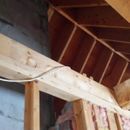Insulation around a center chimney — cape?
How would one insulate around the chimney in the attached pics? Would I start at the ceiling and just put a bunch of Roxul around it? How could air sealing work? Fireblock foam?
Bonus question: Is it too late to double stud these walls?
https://picasaweb.google.com/107236736120604165034/Farmcape2?authkey=Gv1sRgCOG04_bu9pLf0gE
GBA Detail Library
A collection of one thousand construction details organized by climate and house part










Replies
The IRC specified 2" of free-air clearance to combustiblbles for masonry chimneys, that MAY NOT BE FILLED with insulation:
" R1003.18 Chimney clearances.
Any portion of a masonry chimney located in the interior of the building or within the exterior wall of the building shall have a minimum air space clearance to combustibles of 2 inches (51 mm). Chimneys located entirely outside the exterior walls of the building, including chimneys that pass through the soffit or cornice, shall have a minimum air space clearance of 1 inch (25 mm). The air space shall not be filled, except to provide fire blocking in accordance with Section R1003.19."
http://publicecodes.cyberregs.com/icod/irc/2012/icod_irc_2012_10_par061.htm
You are allowed to install non-combustible sheet metal air barriers sealed to the masonry where it passes between floors, etc:
"R1003.19 Chimney fireblocking.
All spaces between chimneys and floors and ceilings through which chimneys pass shall be fireblocked with noncombustible material securely fastened in place. The fireblocking of spaces between chimneys and wood joists, beams or headers shall be self-supporting or be placed on strips of metal or metal lath laid across the spaces between combustible material and the chimney. "
http://publicecodes.cyberregs.com/icod/irc/2012/icod_irc_2012_10_par062.htm
The code is confusing. First it says there must be 2 inches clearance to combustibles, implying that non-combustibles do not need any clearance. Then it says the space shall not be filled, period, except for fire blocking. Why do they mention "to combustibles" at all if it seems that combustibility doesn't actually matter -- there simply must be 2" of space (except fireblocking)?
One solution is to use vermiculite or perlite sheets.
http://www.schundler.com/composites.htm
http://www.dupreminerals.com/en/products/micalite-vermiculite-boards
http://www.vitcas.com/vermiculite-board-insulations
Asbestos would be perfectly fine if they had not made political hay with it. Asbestos can easily be processed and rendered inert (i.e not bioavailable) with the right technology. It is the perfect insulator. Today you can buy vermiculite without asbestos but at one time there were mixed to make insulation.
I found this pic that I think describes what the IRC was going for..
Stephen,
As usual, the code could be better written. But here is the usual interpretation:
1. On the top side of the ceiling framing (floor joists, from the attic perspective), a sheet-metal air barrier tight to the chimney is acceptable. The seams between adjacent pieces of sheet metal can be caulked with high-temperature silicone caulk.
2. Above this sheet metal, in the attic itself, where there is no adjacent framing, it is acceptable to wrap the chimney in mineral wool batts. These batts can be held in place with steel wire. Once the mineral wool is installed, you can insulate with cellulose, to any depth you want, but no higher than the mineral wool batts. (The cellulose shouldn't touch the bricks of the chimney.)
Stephen,
Q. "Is it too late to double stud these walls?"
A. I'm not sure that I understand your question. If you want to install a second stud wall on the interior of your existing walls, you certainly can. All of the usual work would need to be done: relocate electrical boxes as necessary, pay attention to air barrier continuity, come up with a plan to insulate rim joist areas, and make sure that you do a good job of insulating partition intersections.
Perhaps you are really asking, "Would the investment in a double-stud wall make economic sense?"
.
Martin, does it make economic sense?
"Perhaps you are really asking, "Would the investment in a double-stud wall make economic sense?"
Stephen,
Q. "Does it make economic sense?"
A. Probably not. But there is no real way to answer the question without knowing more about your climate, your energy costs, your labor and material costs, and your payback expectations. For more information on this topic, see Payback Calculations for Energy-Efficiency Improvements.